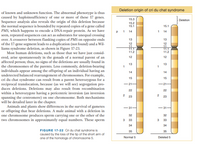
Human Anatomy & Physiology (11th Edition)
11th Edition
ISBN: 9780134580999
Author: Elaine N. Marieb, Katja N. Hoehn
Publisher: PEARSON
expand_more
expand_more
format_list_bulleted
Concept explainers
Question
Look at Figure 17-22 and state which bands are missing
in the cri du chat deletion.

Transcribed Image Text:Deletion origin of cri du chat syndrome
of known and unknown function. The abnormal phenotype is thus
caused by haploinsufficiency of one or more of these 17 genes.
Sequence analysis also reveals the origin of this deletion because
the normal sequence is bounded by repeated copies of a gene called
PMS, which happens to encode a DNA-repair protein. As we have
seen, repeated sequences can act as substrates for unequal crossing
over. A crossover between flanking copies of PMS on opposite ends
of the 17-gene segment leads to a duplication (not found) and a Wil-
liams syndrome deletion, as shown in Figure 17-23.
Most human deletions, such as those that we have just consid-
ered, arise spontaneously in the gonads of a normal parent of an
affected person; thus, no signs of the deletions are usually found in
the chromosomes of the parents. Less commonly, deletion-bearing
individuals appear among the offspring of an individual having an
undetected balanced rearrangement of chromosomes. For example,
cri du chat syndrome can result from a parent heterozygous for a
reciprocal translocation, because (as we will see) segregation pro-
duces deletions. Deletions may also result from recombination
within a heterozygote having a pericentric inversion (an inversion
spanning the centromere) on one chromosome. Both mechanisms
will be detailed later in the chapter.
Animals and plants show differences in the survival of gametes
or offspring that bear deletions. A male animal with a deletion in
one chromosome produces sperm carrying one or the other of the
two chromosomes in approximately equal numbers. These sperm
15.3
Deletion
15.2
15.1
15.1
P 1 14
1 14
13
13
12
12
11
11.1
11.2
11.2
12
12
13
13
14
14
15
15
-21-
-21-
22
22
2
23
23
-31-
-31-
32
32
3
33
3
33
34
34
FIGURE 17-22 Cri du chat syndrome is
caused by the loss of the tip of the short arm of
one of the homologs of chromosome 5.
35
35
Normal 5
Deleted 5
Expert Solution
This question has been solved!
Explore an expertly crafted, step-by-step solution for a thorough understanding of key concepts.
This is a popular solution
Trending nowThis is a popular solution!
Step by stepSolved in 2 steps

Knowledge Booster
Learn more about
Need a deep-dive on the concept behind this application? Look no further. Learn more about this topic, anatomy-and-physiology and related others by exploring similar questions and additional content below.Similar questions
- When stained with Giemsa (G-Banding staining), the centromere will be stained: Question 28 options: more robustly (dark band) less robustly (light band)arrow_forwardExplain how deletions and duplications occur?arrow_forwarda- What is De Bruijn graph, and why it is used? b- Given the folowing string ACGCGTCG. draw De Bruijn graph where K-3arrow_forward
arrow_back_ios
arrow_forward_ios
Recommended textbooks for you
 Human Anatomy & Physiology (11th Edition)Anatomy and PhysiologyISBN:9780134580999Author:Elaine N. Marieb, Katja N. HoehnPublisher:PEARSON
Human Anatomy & Physiology (11th Edition)Anatomy and PhysiologyISBN:9780134580999Author:Elaine N. Marieb, Katja N. HoehnPublisher:PEARSON Anatomy & PhysiologyAnatomy and PhysiologyISBN:9781259398629Author:McKinley, Michael P., O'loughlin, Valerie Dean, Bidle, Theresa StouterPublisher:Mcgraw Hill Education,
Anatomy & PhysiologyAnatomy and PhysiologyISBN:9781259398629Author:McKinley, Michael P., O'loughlin, Valerie Dean, Bidle, Theresa StouterPublisher:Mcgraw Hill Education, Human AnatomyAnatomy and PhysiologyISBN:9780135168059Author:Marieb, Elaine Nicpon, Brady, Patricia, Mallatt, JonPublisher:Pearson Education, Inc.,
Human AnatomyAnatomy and PhysiologyISBN:9780135168059Author:Marieb, Elaine Nicpon, Brady, Patricia, Mallatt, JonPublisher:Pearson Education, Inc., Anatomy & Physiology: An Integrative ApproachAnatomy and PhysiologyISBN:9780078024283Author:Michael McKinley Dr., Valerie O'Loughlin, Theresa BidlePublisher:McGraw-Hill Education
Anatomy & Physiology: An Integrative ApproachAnatomy and PhysiologyISBN:9780078024283Author:Michael McKinley Dr., Valerie O'Loughlin, Theresa BidlePublisher:McGraw-Hill Education Human Anatomy & Physiology (Marieb, Human Anatomy...Anatomy and PhysiologyISBN:9780321927040Author:Elaine N. Marieb, Katja HoehnPublisher:PEARSON
Human Anatomy & Physiology (Marieb, Human Anatomy...Anatomy and PhysiologyISBN:9780321927040Author:Elaine N. Marieb, Katja HoehnPublisher:PEARSON

Human Anatomy & Physiology (11th Edition)
Anatomy and Physiology
ISBN:9780134580999
Author:Elaine N. Marieb, Katja N. Hoehn
Publisher:PEARSON

Anatomy & Physiology
Anatomy and Physiology
ISBN:9781259398629
Author:McKinley, Michael P., O'loughlin, Valerie Dean, Bidle, Theresa Stouter
Publisher:Mcgraw Hill Education,

Human Anatomy
Anatomy and Physiology
ISBN:9780135168059
Author:Marieb, Elaine Nicpon, Brady, Patricia, Mallatt, Jon
Publisher:Pearson Education, Inc.,

Anatomy & Physiology: An Integrative Approach
Anatomy and Physiology
ISBN:9780078024283
Author:Michael McKinley Dr., Valerie O'Loughlin, Theresa Bidle
Publisher:McGraw-Hill Education

Human Anatomy & Physiology (Marieb, Human Anatomy...
Anatomy and Physiology
ISBN:9780321927040
Author:Elaine N. Marieb, Katja Hoehn
Publisher:PEARSON